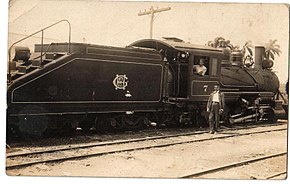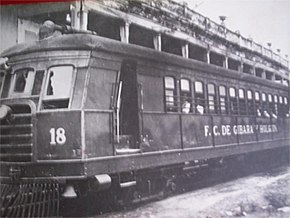Ferrocarril Gibara – Holguín
| Gibara – Holguín | |||||||||||||||||||||||||||||
|---|---|---|---|---|---|---|---|---|---|---|---|---|---|---|---|---|---|---|---|---|---|---|---|---|---|---|---|---|---|
|
Steam locomotive No. 7
| |||||||||||||||||||||||||||||
|
Rail bus no.18
| |||||||||||||||||||||||||||||
| Route length: | 30 km | ||||||||||||||||||||||||||||
| Gauge : | 914 or 1067 mm | ||||||||||||||||||||||||||||
|
|||||||||||||||||||||||||||||
The Ferrocarril Gibara – Holguín was a narrow-gauge railway from Gibara to Holguín in Cuba that was just over 30 kilometers long .
planning
The first plans for a railway line from Gibara to Holguín came up before the Ten Years' War (1868–1878), but they were not implemented until 1883.
The building was promoted by José Homobono Beola y Valenzuela (born November 13, 1850) among others . He came from Coro in Venezuela , where he was born to Don José Ignacio de Beola y Ustoa and Doña Cecilia Valenzuela de Banegas y Díaz. His mother did not know who her parents were, as they simply left her as a baby in the entrance gate of the house of the Valenzuela family in Gibara, where she was raised and given her last name.
José Beola was an accomplished businessman who traded with companies in Spain, Germany, and the United States. The preparatory meeting for the start of the construction of the Gibara and Holguín Railway was held on his premises. He managed to acquire 80.9% of the shares and to fill the supervisory board with his relatives.
construction
Construction began on May 31, 1883. With the construction of the railway, Beola wanted both to stimulate trade in agricultural products in the area and to exert a greater economic influence on Holguín. The concession was awarded to him, Javier Gonzalez Longori and other business partners in 1884.
The first 10 kilometer stretch from Gibara to Cantimplora was put into operation in 1885. It runs through Cuba's only rail tunnel. However, disputes due to the different economic interests of the residents of Gibara and Holguín delayed construction progress, so that the just over 30 kilometers long railway line was not completed until 1894, when the 8 kilometer section from San Marcos de Auras (today Floro Pérez ) to Holguín was put into operation.
business
In 1900 the Ferrocaril de Gibara – Holguin had an income of $ 12,859. It was finally shut down in 1956.
Old postcards
Individual evidence
- ^ A b Cesar Hidalgo, Félix Castell and Carlos Sánchez Vera: Breve e incompleta historia del transporte público en Holguín October 22, 2016. Accessed February 20, 2018.
- ^ A b c d Oscar Zanetti and Alejandro Garcia: Sugar and Railroads: A Cuban History, 1837-1959. Univ. of North Carolina Press, 2017. p. 153.
- ↑ a b Enrique Doimeadios: José H. Beola, el último de los capitalistas afortunados de Gibara. May 16, 2012. Retrieved February 20, 2018.
- ↑ a b Desde Hialeah: Holguin "Ciudad de los Parques" - Ferrocarril Gibara -Holguin. May 31, 2017. Retrieved February 20, 2018.
- ^ William H. Carson: Report of the Special Commissioner of Railroads to the Military Governor . In: Leonard Wood: Civil Reporte of the Military Governor. Havana, 1901, pp. 273-275.
Coordinates: 21 ° 6 ′ 9.1 ″ N , 76 ° 7 ′ 50.9 ″ W.






